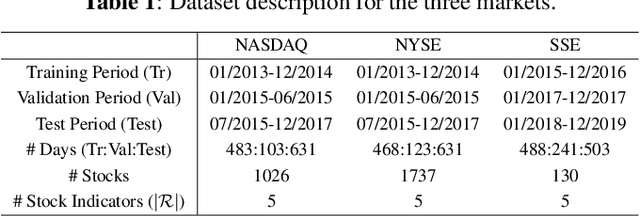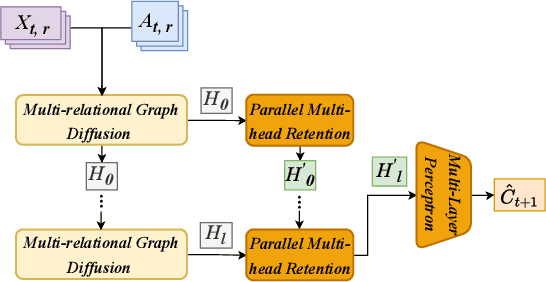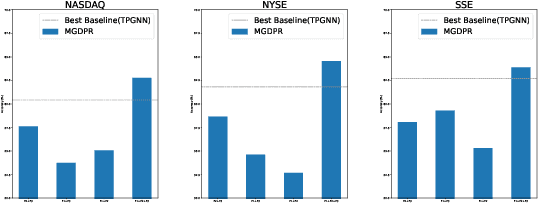Zinuo You
Risk-aware black-box portfolio construction using Bayesian optimization with adaptive weighted Lagrangian estimator
Apr 18, 2025Abstract:Existing portfolio management approaches are often black-box models due to safety and commercial issues in the industry. However, their performance can vary considerably whenever market conditions or internal trading strategies change. Furthermore, evaluating these non-transparent systems is expensive, where certain budgets limit observations of the systems. Therefore, optimizing performance while controlling the potential risk of these financial systems has become a critical challenge. This work presents a novel Bayesian optimization framework to optimize black-box portfolio management models under limited observations. In conventional Bayesian optimization settings, the objective function is to maximize the expectation of performance metrics. However, simply maximizing performance expectations leads to erratic optimization trajectories, which exacerbate risk accumulation in portfolio management. Meanwhile, this can lead to misalignment between the target distribution and the actual distribution of the black-box model. To mitigate this problem, we propose an adaptive weight Lagrangian estimator considering dual objective, which incorporates maximizing model performance and minimizing variance of model observations. Extensive experiments demonstrate the superiority of our approach over five backtest settings with three black-box stock portfolio management models. Ablation studies further verify the effectiveness of the proposed estimator.
Multi-relational Graph Diffusion Neural Network with Parallel Retention for Stock Trends Classification
Jan 05, 2024



Abstract:Stock trend classification remains a fundamental yet challenging task, owing to the intricate time-evolving dynamics between and within stocks. To tackle these two challenges, we propose a graph-based representation learning approach aimed at predicting the future movements of multiple stocks. Initially, we model the complex time-varying relationships between stocks by generating dynamic multi-relational stock graphs. This is achieved through a novel edge generation algorithm that leverages information entropy and signal energy to quantify the intensity and directionality of inter-stock relations on each trading day. Then, we further refine these initial graphs through a stochastic multi-relational diffusion process, adaptively learning task-optimal edges. Subsequently, we implement a decoupled representation learning scheme with parallel retention to obtain the final graph representation. This strategy better captures the unique temporal features within individual stocks while also capturing the overall structure of the stock graph. Comprehensive experiments conducted on real-world datasets from two US markets (NASDAQ and NYSE) and one Chinese market (Shanghai Stock Exchange: SSE) validate the effectiveness of our method. Our approach consistently outperforms state-of-the-art baselines in forecasting next trading day stock trends across three test periods spanning seven years. Datasets and code have been released (https://github.com/pixelhero98/MGDPR).
DGDNN: Decoupled Graph Diffusion Neural Network for Stock Movement Prediction
Jan 03, 2024



Abstract:Forecasting future stock trends remains challenging for academia and industry due to stochastic inter-stock dynamics and hierarchical intra-stock dynamics influencing stock prices. In recent years, graph neural networks have achieved remarkable performance in this problem by formulating multiple stocks as graph-structured data. However, most of these approaches rely on artificially defined factors to construct static stock graphs, which fail to capture the intrinsic interdependencies between stocks that rapidly evolve. In addition, these methods often ignore the hierarchical features of the stocks and lose distinctive information within. In this work, we propose a novel graph learning approach implemented without expert knowledge to address these issues. First, our approach automatically constructs dynamic stock graphs by entropy-driven edge generation from a signal processing perspective. Then, we further learn task-optimal dependencies between stocks via a generalized graph diffusion process on constructed stock graphs. Last, a decoupled representation learning scheme is adopted to capture distinctive hierarchical intra-stock features. Experimental results demonstrate substantial improvements over state-of-the-art baselines on real-world datasets. Moreover, the ablation study and sensitivity study further illustrate the effectiveness of the proposed method in modeling the time-evolving inter-stock and intra-stock dynamics.
NeLF-Pro: Neural Light Field Probes
Dec 20, 2023



Abstract:We present NeLF-Pro, a novel representation for modeling and reconstructing light fields in diverse natural scenes that vary in extend and spatial granularity. In contrast to previous fast reconstruction methods that represent the 3D scene globally, we model the light field of a scene as a set of local light field feature probes, parameterized with position and multi-channel 2D feature maps. Our central idea is to bake the scene's light field into spatially varying learnable representations and to query point features by weighted blending of probes close to the camera - allowing for mipmap representation and rendering. We introduce a novel vector-matrix-matrix (VMM) factorization technique that effectively represents the light field feature probes as products of core factors (i.e., VM) shared among local feature probes, and a basis factor (i.e., M) - efficiently encoding internal relationships and patterns within the scene.Experimentally, we demonstrate that NeLF-Pro significantly boosts the performance of feature grid-based representations, and achieves fast reconstruction with better rendering quality while maintaining compact modeling.
 Add to Chrome
Add to Chrome Add to Firefox
Add to Firefox Add to Edge
Add to Edge